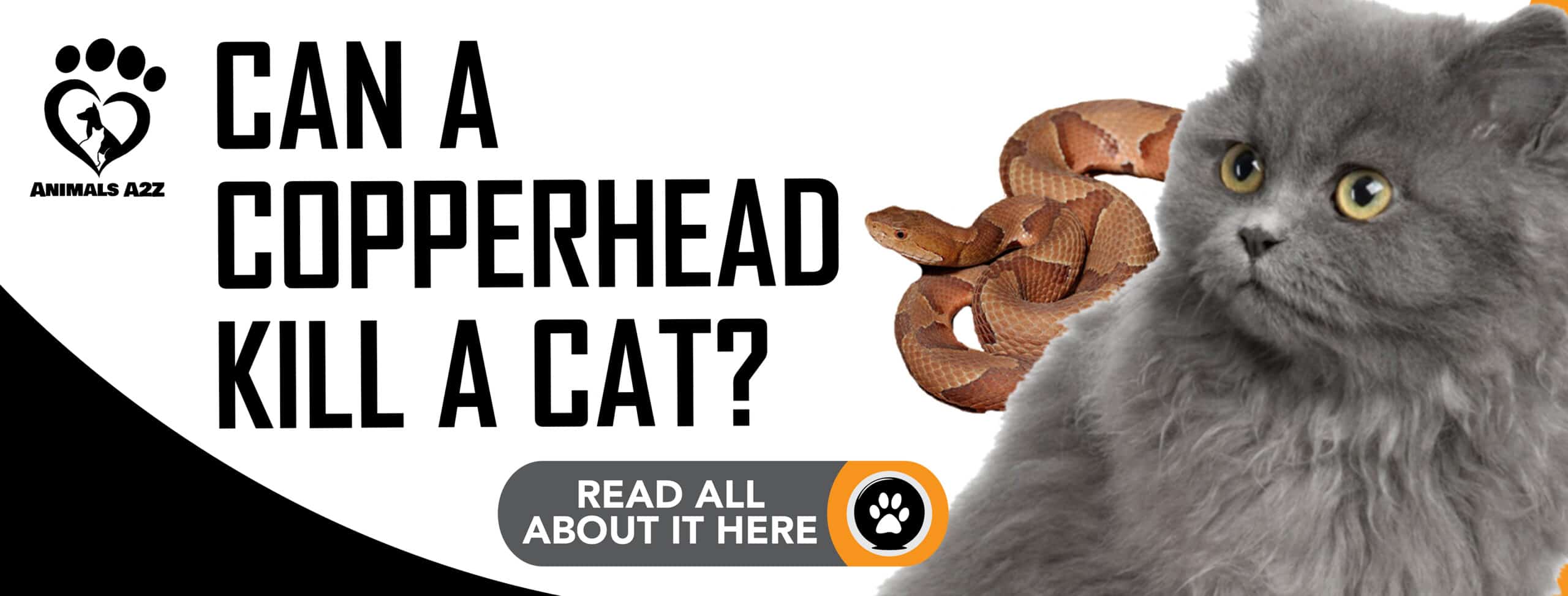Not all snake bites are life-threatening, but they pose a danger to your cats. Some may only require pain management and wound cleaning. Still, others may be horrible and cause paralysis, tissue damage, and possibly death.
So it is advisable to take your pet to a veterinarian sooner rather than later if there is a hint that a venomous snake has bitten your cat. Outcomes with an early diagnosis are usually more survivable.
So does your cat die from a coppperhead bite?
Most likely, no. But id the wound is left unrtreated and gets infected it is lifethreatening for your cat. Stay on this page and find out how to react quickly to make sure your cat is not hurt.
Table of Contents
About Copperheads
In the case of copperheads, this is a more common and abundant type of venomous snake. They are found everywhere from wilderness areas to suburban backyards to city lots, preferring wooded hillsides with rocky outcrops near streams or swampy areas. Wood piles, rock piles, and brush piles are favorite hangouts.
Poisonous snakes do not usually want to use their venom as a defense. They generally give warnings such as rattlesnakes rattling before they hit.
Copperheads are typically elusive, relying on their subtle camouflage of tan, brown, and rust bands to keep them concealed in a litter of grass. Snakes tend to slide away if they can avoid a confrontation, but will strike when cornered or frightened, without giving a rattlesnake-type warning before they do. The young ones are believed to have used their showy tail tips to entice prey into striking distance.
This type of snake often becomes nocturnal in the mid-to-late summer months, taking advantage of the humid, warm nights to hunt their prey from their predators under the added cover of darkness.
Vets warn of the risks to pets from copperhead bites as their bites can be very painful for both humans and pets while they can be challenging to spot, especially when they slide through pine straw.
If a venomous snake approaches a human or a pet, their first reaction is not to strike and bite but to run.
Cats are often bitten by copperheads, which often occur in your pets’ legs and faces. It will generally bite when confronted with a curious pet. Swelling is just one concern, though. Cats become paralyzed with snake bites, wherein signs will often take hours to become evident.
Most of the time, with a copperhead, it’s a lot more about controlling pain and making sure your cats don’t get to grips with infection, which is a potential bite problem. Regardless of the acute toxicity of copperhead venom, most of the bites left untreated can lead to animal death.
As for snake bite recovery, it can vary from a few days to a couple of weeks. Most copperhead bites are treated with wound care such as clipping and cleaning wounds, pain medications, and antibiotics may be needed to treat related infections. Most of the pets will recover.
Common questions about copperheads that can kill a cat
How do you get rid of a copperhead snake in your yard?
The conveniences for these snakes are long grasses and standing water bodies that are not found indoors. So people who have ponds, pools, or weeds are likely to have a copperhead problem. Some of the ways to get rid of a copperhead are to cut your grass, use a snake repellant, get a snake trap, and call professional pest control.
One of the easiest ways to get rid of snakes is to eliminate their preferred hiding places. Lawns should be kept short so that copperhead snakes have fewer places to go.
Besides, when you spread a snake repellant across your yard, you create an unpleasant environment for the snakes. This, in turn, creates a chain reaction wherein the original snake has vanished, and new snakes are reluctant to move into grasses where the repellant has spread.
The second two options are not very different from the previous ones. Using snake traps includes glue boards and cages in which the snake is stuck. You can then release the copperhead at a separate location away from your property. Likewise, the copperhead will either be killed or captured by a team of professionals and taken to another place to be released.
Where do copperhead snakes like to live?
Copperheads are versatile snakes. They can live in terrestrial and semi-aquatic environments, meaning one can survive in rocky areas and marshes, swamps, and nearby lakes. Some were even found living in sawdust or rotting wooden piles where they could stay warm. These snakes prefer long grasses where they can smoothly go unnoticed. Also, properties that already have problems with pets are primary targets for copperheads looking for considerable food supply.
What to do if you encounter a copperhead?
Copperheads are not violent. They won’t attack and won’t attempt to bite unless they are threatened or unintentionally stepped on.
If you see a copperhead on a trail or a campsite, just give it a wide berth and don’t bother it and it’s likely to leave on its own and no longer want to be around humans anymore. Most snake bites happen when people try to capture or kill snakes, so if you leave them alone, you will most likely be safe.
You shouldn’t try to kill it when you find it in your garden or on your property. These snakes are excellent catchers of rats and will be much more effective in keeping vermin than a cat. You can call a professional if you wish to remove it from your property.
Conclusion
Copperheads are shy and not aggressive snakes. No need to kill snakes insight. They won’t attack if you know how to identify a copperhead snake, and you give them the space they require. Snakes are beautiful creatures and shouldn’t give you any problems if you try to understand them and treat them properly. Copperheads are dangerous to your cat when snake bites are left untreated, leading to the death of your pet.


